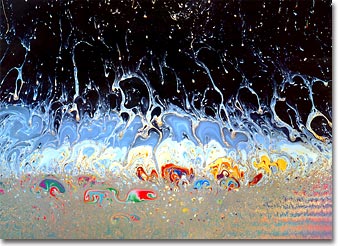Karl E. Deckart
Soap Bubble Gallery: Image Sixteen
German photographer and artist Karl E. Deckart is known for his thorough, precise, and beautiful work both in photography through the microscope and with macro camera systems. This gallery of interference photographs made with soap films is a testament to both Deckart's skill as a photographer and his understanding of the physical phenomena that surround our everyday lives. Presented below is soap bubble image number sixteen in small format. Click on the image to download a larger version.

|
Macrophotography of thin soap films freely suspended on a 4 x 4-inch wire frame was conducted with a Linhof large-format bellows camera system utilizing 4 x 5-inch sheet film and imaged using an apo-macro Nikon large format Nikkor-AM ED 210 mm f-5.6 lens. To prepare the soap film, equal parts of water, glycerin, and dishwasher detergent are thoroughly mixed in a container until a solution containing evenly sized micelles is achieved. A freestanding film is formed by dipping the wire frame into the solution and withdrawing carefully to maintain an even film thickness and avoid disruption of material flow across the frame rails. After suspension, the film was illuminated by a reflected light source positioned a few degrees from the camera system. The light was passed through a diffusion screen to avoid bright spots and provide an even illumination across the field. No polarizers were employed in photomacrography of soap thin films. Image ©1999 by Karl E. Deckart. All rights reserved. |
Light reflecting from the surface of soap bubbles undergoes both constructive and destructive interference to produce a rainbow-like spectrum of color. The phenomenon has been known for thousands of years, but has only recently been explained. Thin films of lipid-like soap molecules are formed like biological membranes and grow together under the pressure of surface tension forces to form large soap bubbles. Some of the incident light is reflected from the outer layer of molecules, while another portion crosses through the membrane to impact the inner surface. When the two reflected light rays interact (one reflected from the top surface and the other from the bottom) they interfere to produce the color seen in soap bubbles.
BACK TO THE SOAP BUBBLE GALLERY
